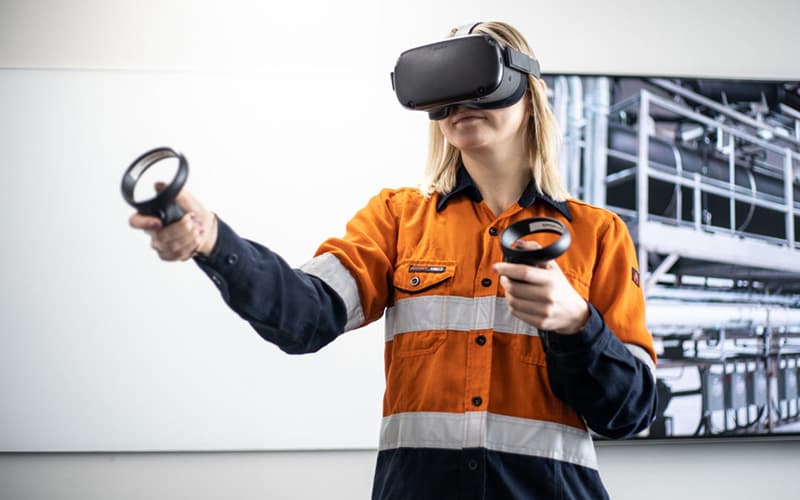Peering down from towering structures, crawling into confined spaces and extinguishing raging bushfires. When it comes to workplace training, you’ll be hard-pressed to find a medium more immersive, more captivating, more thrilling than virtual reality (VR) training.
If you’ve experienced the extraordinary world of VR, you’ll know what we’re talking about.
If you haven’t, it’s likely you will in the future, because the global AR and VR market is expected to grow to USD $209.2 billion by 2022. More and more companies (including BP, KFC and Ford) are leveraging the technology, particularly in the training room.
But you don’t have to be a multi-billion-dollar company to take advantage of virtual reality. Medium sized businesses like local governments and construction companies are reaping the rewards too.
But before we get into the benefits of VR training, let’s start with the basics.
What is Virtual Reality Training?
Before we bring training into the mix, let’s start by talking about virtual reality (VR).
Virtual reality is a computer-generated, 3D simulation that fully immerses the user into a scenario via a headset and (sometimes) hand controllers.
VR videos are either shot with a 360-degree camera or fully animated. This footage is then overlaid with motion graphics and sound effects.
At Epigroup, we favour filming scenes with 360 cameras as opposed to creating fully animated scenes. Fully animated VR projects don’t look as realistic and take away experiencing an environment exactly as it is.
Once you’ve created your VR experience, it’s either loaded straight onto an all-in-one VR headset (such as the Meta Quest 2), or onto a laptop that’s tethered to a VR headset.
When the user puts on the headset, the 360 environment allows them to look left, right, up and down, or move around to explore their full surroundings. The content is also stereoscopic 3D, which gives the scenes depth, replicating the way the human eyes work.
Hand controllers are optional and enable users to pick things up, press buttons, operate machines, drive vehicles etc. They can also be used to move yourself around your virtual environment with a ‘point and shoot’ function. If you want to do cool stuff like this, you need to build controller functions into your project.
This super memorable experience makes VR ideal for training. Particularly for health and safety. By creating relatable and realistic scenarios, you give people the opportunity to walk in someone else’s shoes, visit new places and perform life-threatening tasks in the comfort of the training room.
On that note, let’s dive into the benefits of VR for training.
How is Virtual Reality used in training?
VR training can be as simple or as complex as you like. It can form part of a face-to-face workshop, or be an entirely self-contained training program. The choice is yours.
Basic projects involve putting on a headset and watching and listening (whether that’s someone virtually in front of you or a voice-over), looking at certain areas when instructed.
Basic Virtual Reality Training Examples:
- Guided tours – have your experts walk and talk trainees through offshore facilities, a large factory or processing facility.
- Spot the hazards – ideal for safety training, users can look around to spot hazards in your workplace.
- A day in the life of… – walk in another colleague’s shoes to understand their day-to-day duties.
- Exploration – transport people to a luxury destination, rural vineyard or an architect’s design.
If you want more technical (and out-of-this-world cool) training, you can opt for a more advanced project involving more complex interactivity and using the hand controllers. Create games, choose-your-own-adventure storylines and watch the consequences of your actions unfold.
Advanced Virtual Reality Training Examples:
- Escape room – trainees must perform a process successfully to leave the room.
- Rescue missions – trainees could board a helicopter, land it safely and save virtual lives.
- Performing tasks – this could be anything from operating a crane to operating on a patient.
What are the benefits of VR training?
1. You Can Fail Safety
Did you crash a car? Detonate a bomb? Sink a boat? No worries!
One of the biggest pros of VR is that you can set up scenarios that would be impossible or high risk in real life.
With VR, there’s no threat to safety or assets. It allows workers to fail safely and see the consequences of failing, all in the comfort of the training room. This is what makes VR perfect for health and safety training.
2. Improved Performance
When it comes to job performance, competency is key.
New workers can be apprehensive about certain tasks because they don’t want to make a mistake – which is understandable – or they need time to familiarise themselves with the new environment and equipment. But if they’ve already experience the task virtually, their confidence and level of expertise is accelerated.
On-the-job training is often provided by multiple staff, and is often a case of whoever is available at the time to conduct the training. . This can lead to inconsistent training and even passing on bad habits
Virtual reality training ensures everyone receives the same, best practice instructions. The organisation can be confident they’ve shown their team how they should complete a task, not how one person thinks it should be done.
3. Improved Retention
It’s pretty hard to stay focused when you’re staring at a PowerPoint for hours. If your team is unengaged, their retention rate will drop, which means time and money down the drain for your organisation.
Studies show that experiential learning can improve retention rates and quality of learning by a whopping 75-90%.
VR training feels more real because you’re experiencing tasks and impressions, and research has shown this link with emotions helps humans remember.
It’s much easier to recall a situation if you felt like you were there. You’re reminded of the emotions you felt at the time and what considerations you made before taking action.
4. No Distractions
When you put on a VR headset, you shut out the world and all of its distractions. Because you’re so mentally engaged, your senses become hyper alert too.
A University of Nottingham group created an immersive multi-sensory virtual office fire with heat, the smell of smoke, poor visibility and the sound of fire. Another group completed PowerPoint training.
One week later, participants of both were tested. The results showed that the PowerPoint trained group had more knowledge directly after training, but had a larger decrease in knowledge one week later compared to the VR group.
A lot of us learn through performing actions – not by reading or being told – so virtual reality allows learners to quickly upskill and hold onto that new knowledge.
5. Portable and Remote
There’s nothing like a pandemic to shake up the way we work and train employees.
Remote learning has been a buzz word since COVID hit.
VR’s portability makes it the perfect solution for remote training. Once you’ve loaded your content onto your headset or mobile phone, the training can go straight to the trainees rather than the workers going elsewhere.
This is particularly ideal if you need to train FIFO workers. Instead of flying them all down to a training facility, you can take the training to them.
How much does a VR training project cost?
Like most commercial products, there are many options and the price depends on what you want and who provides it. VR has the same basic costs as any conventional training: content development and equipment. The key difference is the reduction in reliance on paying for training facilitator.
You can purchase a simple, off-the-shelf VR applications via certain websites and marketplaces, but they’re usually priced per user on a subscription basis. This space is relatively new, so you might struggle finding suitable for your company.
Other companies (like us) create custom VR content that features your site and your people.
A basic VR tour – where the user simply ’looks and listens’ within a 360 VR environment – you’re upwards of $10K.
However, if you want an advanced interactive project that utilises the controllers, you’re upwards of $30K.
When it comes to equipment, you need to factor in the costs of headsets – or perhaps you’re okay with using mobile phones. Which models do you want and how many will you need?
The other thing to consider is the roll-out. Will you dedicate a room on-site or head office where the headsets live? Will you train someone internally to manage your headsets, keeping them charged and trouble-shooting if and when needed? Of course, this can also be outsourced to companies like us.
Finally, the trainer. Will you need to hire someone to conduct the training, or will you train someone up in-house to use the tech?
VR can be a cheaper option than face-to-face workshops, depending on how many employees you need to train. For example, if your total project costs $30,000 to produce and you have 200 employees to train, this works out at $150 per person. As you enrol new trainees, this per person cost only gets smaller over time.
How long does a project take to create?
Again, this depends.
Off-the-shelf VR projects can be handed over in minutes.
Custom VR products involve scripting, storyboarding, shooting and editing (or illustrating and animating), before overlaying motion graphics, sound effects and any movements involving the hand controllers, so it can take 1-3 months depending on its complexity.
How do I kick-off a VR training project?
You’ve made it this far, so it sounds like VR training is ticking all your boxes!
To work out if it’s an ideal training solution for your company, colleagues and training goals, we strongly advise you try the technology out yourself first. It’s hard to plan your project without really understanding VR and how immersive it is.
If you’re based in Perth or Western Australia and want to try VR for yourself, get in touch and we’ll make it happen.
Once you’ve done this, start contacting VR companies for quotes – they should be able to help you with planning, scripting and storyboarding too.
Then get excited to produce the most extraordinary training content available today.


